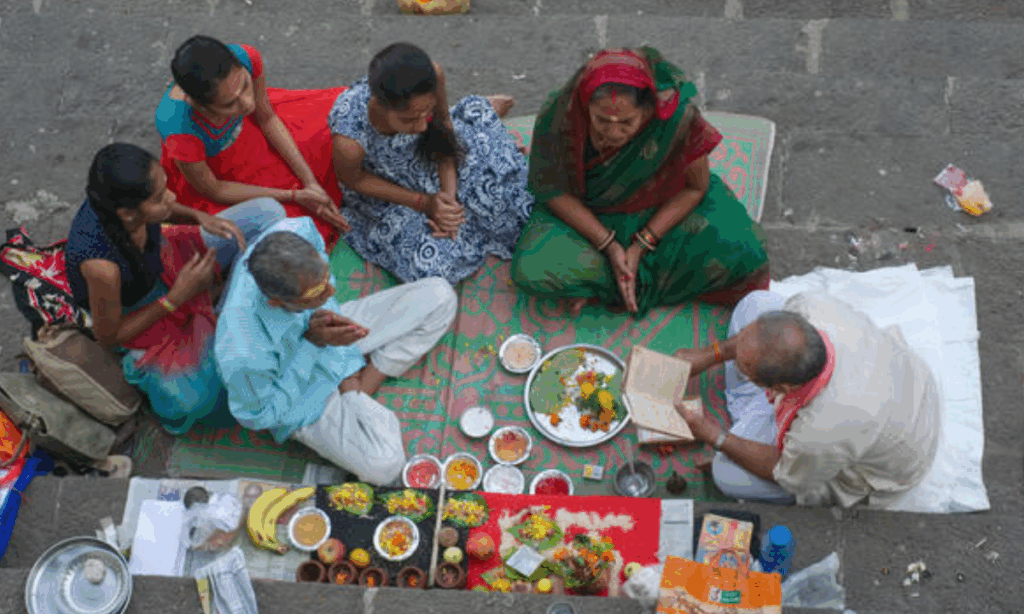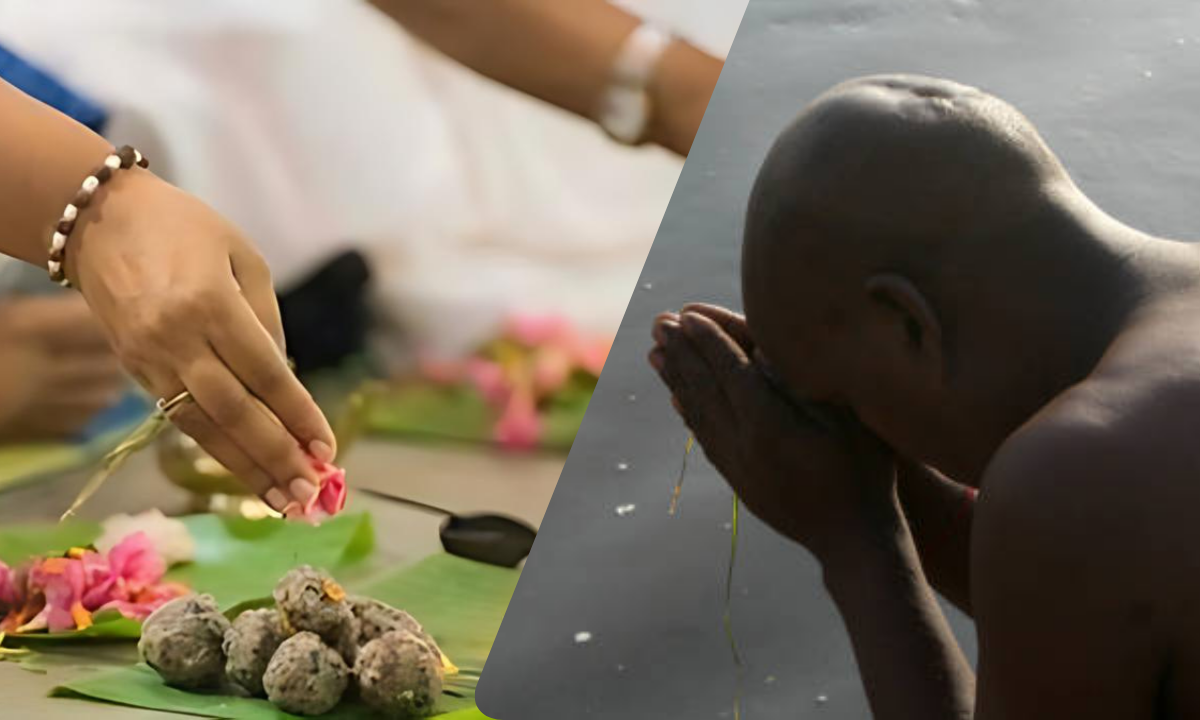After death rituals are an essential part of Hindu traditions. They guide the departed soul and offer closure to the family. Two important components of these rituals are Shraddha and Pind Daan. These practices honour ancestors, ensure the peace of the departed soul, and preserve cultural values. With professional funeral services in India like Kaashimukthi, families can follow these rituals smoothly while maintaining devotion and dignity.
In this blog, we will explore the significance of the Shraddha ceremony and Pind Daan, their timing, and the rules for Asthi Visarjan, providing families with practical guidance for after death rituals.
By the end, you will understand how these ceremonies strengthen spiritual connections while supporting grieving families.
What is the Shraddha Ceremony?

The Shraddha ceremony means a ritual performed to honour and express gratitude to ancestors. It is usually performed after cremation and at intervals afterwards. The ceremony helps ensure the soul’s peaceful journey and brings blessings to the family.
The Shraddha ceremony after death can be performed on specific days, such as the 10th, 11th, or 13th day. The annual shraddha ceremony is observed each year to remember the departed and pay respect. The Shraddha ceremony is not only a religious obligation but also a way for families to reflect on the values and teachings of their ancestors.
Understanding Pind Daan
Pind daan means the offering of rice balls to ancestors. These offerings nourish the soul and help it attain peace. It is often performed at sacred sites like Pind Daan at Gaya, which is considered highly auspicious in Hindu tradition.
Pind Daan is usually done during the Shraddha ceremony and is central to Hindu after death rituals. The ritual symbolises connecting with ancestors, offering food, and seeking spiritual guidance and blessings.
| Ritual | Purpose |
|---|---|
| Shraddha ceremony | Honour ancestors and bless the departed soul |
| Pind Daan | Nourish the soul and ensure peace |
| Annual Shraddha | Remember ancestors yearly |
Asthi Visarjan: Completing the Rituals
Asthi Visarjan is the immersion of ashes in a holy river. It marks the final step of cremation rituals, symbolising the return of the body to nature and freeing the soul.
| Aspect | Details |
|---|---|
| What it is | Immersion of ashes in a sacred river |
| Purpose | Spiritual release and honouring the departed |
| Timing | Performed after cremation; varies by family tradition |
| Rules | Certain days and rituals must be observed |
| Popular Places | Ganga, Yamuna, and other sacred rivers |
Asthi visarjan after how many days depends on family customs, usually within a few days to weeks after cremation. Observing the Asthi Visarjan rules ensures spiritual benefits are fulfilled and maintains the sanctity of the rituals.
Role of a Funeral Director
A funeral director helps families manage all logistics for after death rituals.
They arrange:
- Cremation or burial services
- Ritual items for the Shraddha ceremony and Pind Daan
- Transport and documentation, including death certificates
In cities like Bangalore, funeral services in Bangalore assist families with traditional rituals while taking care of modern needs. Professional services make sure rituals are performed correctly and respectfully. They also guide families through any regional or customary variations in Hindu death rituals.
Timing and Significance
- Shraddha ceremony after death: Usually on the 10th, 11th, or 13th day after cremation.
- Annual Shraddha ceremony: Performed each year to remember ancestors.
- Pind Daan: Often performed during Shraddha ceremonies or at Gaya for higher spiritual merit.
- Asthi Visarjan: Typically, within a few days to weeks after cremation, depending on family customs.
These timings are important to ensure the soul receives blessings and peace. Performing the rituals at the proper time is considered essential for spiritual and cultural reasons.
Tips for Families
- Plan in advance: Keep ritual items and documentation ready.
- Consult a priest: They guide the family through proper procedures.
- Use professional services: funeral services in India, like Kaashimukthi, make arrangements smoother.
- Focus on key rituals: Prioritise the Shraddha ceremony, Pind Daan, and Asthi Visarjan.
- Respect family customs: timings and procedures may vary regionally.
- Prepare spiritually and emotionally: Involve family members in rituals to support collective healing.
Final Thoughts
After death rituals like the Shraddha ceremony, Pind Daan, and Asthi Visarjan form an essential part of Hindu traditions. They honour the departed soul and provide spiritual closure for families.
With professional funeral service providers in India, families can perform these sacred rituals smoothly while observing tradition with care. At Kaashimukthi, we help families uphold customs with devotion and dignity, ensuring every step of after death rituals is handled respectfully and thoughtfully.
These rituals not only support the departed soul but also strengthen family bonds, offering comfort and spiritual fulfilment during a difficult time.
FAQs on Shraddha and Pind Daan
1. What is the Shraddha ceremony?
It is a ritual performed to honour ancestors, ensure the soul’s peace, and seek blessings for the family.
2. What is Pind Daan?
Pind Daan is the offering of rice balls to ancestors, nourishing the soul and helping it attain peace.
3. When is Asthi Visarjan performed?
Asthi Visarjan is typically done within a few days to weeks after cremation, depending on family customs and religious guidance.
4. Can a Funeral Director help with after death rituals?
Yes. They manage logistics, arrange ritual items, coordinate priests, and guide families to ensure rituals are performed correctly.
5. Are professional services necessary for families in cities like Bangalore?
While not mandatory, funeral services in India and other cities make it easier to follow traditions without added stress.

Madhu is an Entrepreneur, a Mentor, a Writer and an Aspiring Car Race Driver. He is Deeply passionate about leveraging Technology and Human Centred Design to make complex care and End of Life Planning easier. With the ultimate aim of Improving the quality of Life in the Twilight years. Madhu is highly educated and Alumni of IIM-Bangalore, Sikkim Manipal University and Bangalore University besides a Rich Industry Experience in the field of Product Management, Design, Supply chain, Finance, Commercial Management and Funeral Services.

